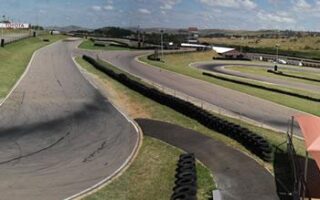Nestled on the outskirts of the bustling cityscape, where asphalt meets adrenaline and the roar of engines fills the air, lies a hidden gem for motorsport enthusiasts — the rally raceway. This vibrant arena, often overshadowed by its circuit racing counterparts, offers a unique blend of thrill, skill, and raw nature that captivates both participants and spectators alike. With its winding trails, unpredictable terrains, and the promise of heart-pounding excitement, the rally raceway serves as a canvas for drivers to showcase their mastery over speed and precision. Whether steeped in tradition or embracing innovation, this dynamic playground is a testament to the ever-evolving world of motorsport, inviting both seasoned racers and curious newcomers to embark on a journey that transcends mere competition. In this article, we will explore the essence of rally raceways, delving into their history, the intricacies of rally racing, and what makes these venues so exhilarating.
Table of Contents
- Exploring the Thrills of Rally Raceway: An Enthusiast’s Perspective
- Navigating the Track: Essential Skills for Aspiring Rally Drivers
- Safety First: Key Gear and Practices for a Secure Racing Experience
- The Future of Rally Racing: Innovations Shaping the Sport
- Q&A
- Wrapping Up
Exploring the Thrills of Rally Raceway: An Enthusiast’s Perspective
Rally raceway is not just a sport; it’s an electrifying experience that captivates the heart and soul of motorsport enthusiasts. As you step onto the track, the unmistakable scent of gasoline mingles with the crisp air, igniting a sense of anticipation. The roar of high-performance engines as they rev to life creates an exhilarating symphony, setting the stage for an unforgettable showdown. Speed, precision, and strategy come together as drivers navigate through a series of challenging terrains, turning each bend and straightaway into a testament of their skill. From the dirt-dusted rally cars to the polished surfaces of the asphalt, every element of a rally race exudes the thrill that keeps fans on the edge of their seats.
One of the prominent attractions of rally racing is the diverse range of vehicles that showcase not only raw power but also innovative engineering. Fans can witness everything from classic beasts to modern marvels as they rally through obstacles. Beyond the vehicles, it’s also the community that adds vibrancy to the raceway atmosphere. Enthusiasts gather to share their passion, with discussions revolving around their favorite drivers and memorable races. Here are a few elements that contribute to the unique culture of rally raceway:
- Adrenalin-pumping events
- Fan interactions and meet-ups
- Custom build showcases
| Feature | Description |
|---|---|
| Vehicle Variety | From vintage classics to cutting-edge hybrids |
| Scenic Tracks | Rugged landscapes and twisting roads |
| High Stakes | Drivers compete for glory and titles |
Navigating the Track: Essential Skills for Aspiring Rally Drivers
To become a successful rally driver, mastering the art of vehicle control is paramount. This skill enables drivers to maneuver their cars effectively on diverse terrains, from gravel roads to snow-covered paths. Essential techniques include:
- Controlled Drifting: Understanding weight transfer to maintain control during sharp turns.
- Throttle Control: Knowing when to accelerate or decelerate can mean the difference between maintaining speed and losing control.
- Early Braking: Anticipating corners and obstacles to slow down appropriately without losing momentum.
Additionally, good navigation skills are critical in rally driving, where routes can be complex and challenging. Effective communication with your co-driver can enhance your performance significantly. Key aspects to focus on include:
| Skill | Description |
|---|---|
| Route Reading | Quickly assessing the road ahead based on pace notes. |
| Trusting Your Co-driver | Building a strong partnership for effective communication under pressure. |
| Familiarization | Practicing on terrain similar to race day conditions to enhance confidence. |
Safety First: Key Gear and Practices for a Secure Racing Experience
When it comes to rally racing, prioritizing safety is crucial for both participants and spectators. Investing in the right gear not only enhances performance but also ensures protection against potential hazards on the track. Essential items include:
- Helmets: A certified racing helmet is non-negotiable. Make sure it meets appropriate safety ratings.
- Racing Suits: Look for flame-resistant suits made of Nomex or similar materials for optimal protection.
- Gloves and Shoes: Specialized gloves offer grip and protection, while non-slip shoes enhance control.
- Harness Systems: A five- or six-point harness keeps you securely in place, reducing the risk of injury in case of a collision.
In addition to having the proper equipment, adopting sound safety practices on and off the track is essential. Always conduct a thorough inspection of the vehicle before every race, focusing on the brakes, tires, and safety systems. Creating a list can help ensure nothing is overlooked:
- Check Fluid Levels: Ensure oil, coolant, and fuel levels are adequate.
- Tire Condition: Inspect for wear and ensure proper inflation.
- Brake Functionality: Test the responsiveness of brakes.
- Emergency Kit: Carry a well-stocked kit including first aid supplies and fire extinguishers.
The Future of Rally Racing: Innovations Shaping the Sport
As rally racing embraces cutting-edge advancements, numerous innovations are redefining the sport’s landscape. One of the most significant developments has been the integration of electric vehicles (EVs), which not only reduce carbon footprints but also enhance performance through instantaneous torque delivery. Additionally, teams are investing in augmented reality (AR) systems that provide drivers with real-time data, helping them navigate challenging terrains more effectively. Innovations such as these are pushing the boundaries of what is possible, turning traditional rally races into thrilling spectacles of technology and skill.
The role of data analytics cannot be overstated in this evolution. Teams are now equipped with sophisticated telemetry systems that gather insights from various parameters during races. This allows for better decision-making and strategic planning. Notably, the use of drones for course mapping and monitoring environmental conditions is becoming more prevalent, offering a bird’s-eye view that was previously unattainable. This trend is encapsulated in the following table showcasing some of the key innovations influencing rally racing today:
| Innovation | Description |
|---|---|
| Electric Vehicles | Enhances performance with instant torque and reduces emissions. |
| Augmented Reality | Provides drivers with real-time navigational data. |
| Telemetry Systems | Gathers performance data for strategic decisions. |
| Drones | Offers aerial mapping and environmental monitoring. |
Q&A
Q&A: Exploring the World of Rally Raceway
Q: What is a rally raceway?
A: A rally raceway refers to an extensive and diverse terrain used for rally racing events. Unlike traditional racetracks, which typically feature smooth asphalt or paved roads, rally raceways often include a mix of dirt, gravel, forest paths, and even urban settings. This variety provides unique challenges and requires drivers to adapt quickly to changing conditions.
Q: How do rally races differ from other types of motorsport?
A: Rally races are distinct in their format. Instead of racing against other competitors simultaneously on a closed track, rally drivers compete against the clock on predetermined courses. Participants typically navigate multiple stages over several days, making endurance and navigation skills as crucial as speed. Additionally, the terrain and weather can vary widely, adding to the complexity of each race.
Q: What kind of vehicles are used in rally racing?
A: Rally racing employs specially modified vehicles designed to withstand harsh conditions and offer high performance on various surfaces. Commonly, cars are based on production models but are heavily enhanced for durability, speed, and safety. These modifications may include reinforced bodies, advanced suspension systems, and powerful engines tailored for the challenges of rally racing.
Q: Can anyone participate in rally racing?
A: While the thrill of rally racing is accessible to many enthusiasts, participating in official events typically requires a level of experience and certification. Aspiring drivers often start with entry-level races or rally schools before advancing to more competitive stages. Additionally, they must adhere to regulations set by governing bodies like the FIA.
Q: What is the role of co-drivers in rally racing?
A: Co-drivers play a pivotal role in rally racing. They navigate the course using detailed pace notes and communicate vital information to the driver, such as upcoming turns, hazards, and changes in terrain. This teamwork is essential, as co-drivers help ensure the driver stays on track and maximizes their speed while maintaining control. A strong partnership between the driver and co-driver can make or break a rally team’s success.
Q: How do rally races impact local communities?
A: Rally races often have significant effects on local communities, both positive and negative. They can boost local economies by attracting tourists and spectators, leading to increased business for hotels, restaurants, and shops. However, there can also be concerns regarding environmental impact and road use. Organizers often collaborate with local officials to ensure that events benefit the community while minimizing any adverse effects.
Q: What are some of the most famous rally races in the world?
A: Several rally races hold legendary status within the motorsport community. The Monte Carlo Rally, known for its challenging winter conditions, and the Dakar Rally, famous for its grueling desert stages, are among the most prestigious. The World Rally Championship (WRC) also features numerous iconic events that showcase the best of rally racing across various terrains and countries.
Q: How has technology influenced rally racing?
A: Technology has revolutionized rally racing in many ways, from car performance enhancements to advanced navigation systems. Modern rally cars utilize data logging, telemetry, and GPS to help teams analyze performance in real-time. Furthermore, the introduction of hybrid and electric vehicles is reshaping the future of the sport, pushing boundaries while addressing environmental concerns.
Q: What can spectators expect at a rally race?
A: Spectators at a rally race can anticipate an exhilarating experience as they witness powerful vehicles tackle diverse and challenging terrains. Rally events are often designed for spectator engagement, with designated viewing areas that offer exciting vantage points. From the roar of engines to the thrill of high-speed maneuvers, fans are treated to a dynamic show that embodies the spirit of motorsport.
Q: Where can someone find more information on participating or attending a rally race?
A: Enthusiasts can find information on participating in or attending a rally race through official rally organizations, motorsport clubs, and dedicated websites. Many cities host local events and rally schools, providing opportunities for newcomers to get involved. Social media platforms also serve as a valuable resource for connecting with other fans and discovering upcoming events in the rally racing calendar.
Wrapping Up
As the sun sets behind the bustling pits of the rally raceway, a symphony of roaring engines and cheering fans echoes in the air, marking yet another thrilling chapter in the world of motorsport. Here, where precision meets passion, and skill intertwines with sheer adrenaline, the rally raceway stands as a testament to the relentless pursuit of speed and triumph. Whether you’re an aspiring driver or a dedicated fan, the allure of the track continues to inspire and captivate. As the dust settles and the last car crosses the finish line, it’s evident that the spirit of rally racing lives on, inviting new challengers and eager spectators to join in the journey. So, buckle up—there’s always another adventure waiting just around the bend. Until next time, keep the engine running and the thrill alive!


